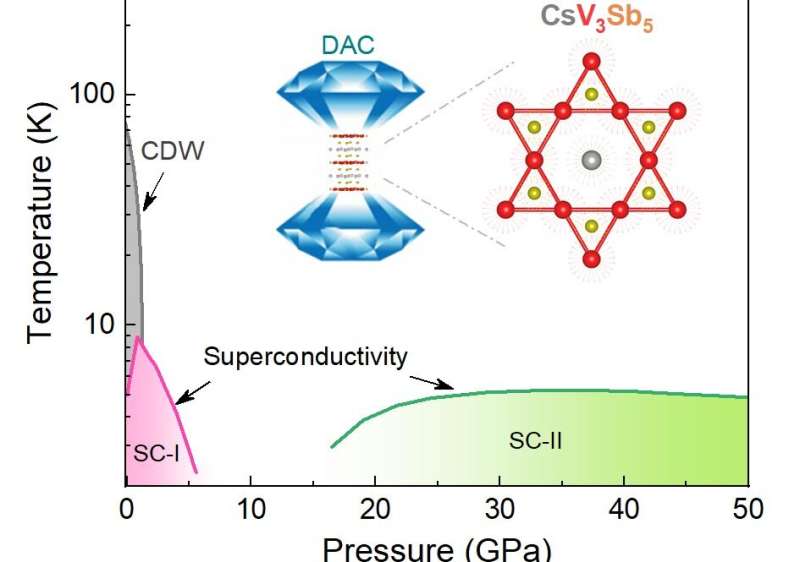Two-dome superconductivity in a kagome superconductor discovered under high pressure

Recently, a research team led by Prof. Yang Zhaorong from the Hefei Institutes of Physical Science (HFIPS) of the Chinese Academy of Sciences (CAS), in collaboration with researchers from the Anhui University and other institutions, discovered pressure-induced two-dome superconductivity in the quasi-two-dimensional topological kagome superconductor CsV3Sb5. This work was published in Physical Review B and selected as Editors' Suggestion.
Owing to its unique geometry, kagome lattice intrinsically hosts electronic flat bands (strong correlations), Dirac band crossings like in graphene, and Van hove singularities, enabling realizations of quantum diversities. Recently, the kagome superconductors AV3Sb5 (A=K, Rb, Cs) have attracted much research interests due to discoveries of superconductivity, chiral charge effect, giant anomalous Hall effect and non-trivial topological electronic bands.
Pressure, as one of the three fundamental thermodynamic parameters, is known as a clean and powerful means to directly manipulate the lattice and further tune the electronic states. Naturally, one may ask how these phenomena interact with each other and what kind of exotic states may emerge for the systems under pressure.
In this research, the team chose CsV3Sb5 as an example since it has the highest superconducting transition temperature of about 5.0 K amongst the systems at ambient pressure. They used the so-called diamond anvil cell to generate high pressures up to 47.9 GPa. They found that the transition temperature first increases and then decreases rapidly under pressure, which is undetectable in the intermediate pressure range of 5–16 GPa.
Unexpectedly, superconductivity reemerges above 16 GPa, with transition temperature first increasing slightly and then almost leveling off.
Therefore, a two-dome superconducting phase diagram was revealed for CsV3Sb5 under high pressure. In terms of the high-pressure synchrotron X-ray diffraction measurements, they didn't find any structural transition but an anomaly in ratio of the lattice parameters just around the same critical pressure, indicating a Fermi surface reconstruction via Lifshitz transition that might be responsible for the reemergence of superconductivity.
Many experiments suggests that the ambient-pressure superconductivity in CsV3Sb5 should be unconventional. In this sense, this work evidences a two-dome superconductivity in the first V-based unconventional superconductor.
In addition to previous reports in tremendous unconventional superconductors like Cu-based, Fe-based and heavy-fermion systems, two-dome superconductivity seems to be a common feature for these systems under external parameters, which may provide an important clue for understanding mechanisms of the unconventional superconductivity.
More information: Zhuyi Zhang et al, Pressure-induced reemergence of superconductivity in the topological kagome metal CsV3Sb5, Physical Review B (2021). DOI: 10.1103/PhysRevB.103.224513
Journal information: Physical Review B
Provided by Chinese Academy of Sciences





















